 |
John & Marjorie Benitz | Page last modified: |
 |
John & Marjorie Benitz | Page last modified: |
The tragic death of John Benitz is burned into the Benitz family history. John was not the only one to perish the morning of March 20th, 1916 – so did his daughter Marjory-Daw, Mrs. Withington and her daughter Helen, Miss Dawney, and MacCrae (the chauffeur).
Sections
The following article was included in the MOSAIC, The Magazine of St. Paul’s School, Cruz Grande, Sierras de Cordoba, Argentina, in its Volume 5, dated 8th July, 1966, No.1.
For those of you that are not aware, St. Paul’s School purchased the “Bellmont” property in November 1964, and after some renovations and new construction, divided the School into Senior and Junior Houses. The Seniors were installed at “Bellmont”, originally called “Villa Josefina” built by the Benitz family. Alfred Benitz owned “El Rincon”, just up the river from Bellmont and another brother called John Benitz built “Cruz Grande” which later became the School Carpentry & Mechanic Shops, and Mrs. Van’s (a St. Paul’s teacher for many years) residence. This property had an alfalfa field and beautiful orchards where the existing playing fields are today. The river that ran by all 3 properties was of course the Cruz Grande, and site of one of its most devastating flash-floods, typical in the Sierras [Hills] from time to time and before the days of dams and represas [catch-basins], which happened on March 15th, 1916.
John (known locally as Don Juan) Benitz’s property, “Cruz Grande”, is the one that was hit by the “creciente” [flash-flood].
Coincidentally, I grew up on that same river, and like my father Frank (Frankie) Watt before me, and his mother Hattie before him, spent some of the most memorable years of my life in the “Hills”, in the same location and playing on the same properties which were built by my ancestors, the Benitz family (my grandmother Hattie Benitz Watt was the first Benitz born in Argentina), in the late 1800’s early 1900’s.
On various occasions during my 9 years from 1964 to 1972 at St. Paul’s I personally witnessed the Cruz Grande in flood. Months and months just a trickle of water, barely surfacing in the odd pool, the most famous of all pools being “Los Cajones” [?? El Cajón], just down from El Rincón, where we would go to swim, long before the days of our new pool built at Bellmont in Aug. 1965, and then one night we would hear the distant rumbling of storm, lightning, wind, and later of rocks, trees and everything else that was in its path being swept by the “vado” [river ford] that ran between Bellmont and the Workshops [former “Cruz Grande” house]. The “big wall” that still protects that property today was not a big wall at all back in March 1916, and if one looks at it carefully, one can see not one but three different levels having been added on over the years, as subsequent “crecientes” (flash-floods) deposited more rock and sand at its base.
Josephine (Jo) Benitz, many years later lovingly nicknamed “Bijou”, was the lone survivor of those swept down the river. She went on to live a long life, serving time in [WWI &] WW II as an Ambulance driver, and later became Jo Webster [m: 1928]. One of her grandchildren was Gavin L., also a boarder at St. Pauls. Because of our relationship, I had the privilege of having spent many exeats from School staying with “Bijou” on her chacra [small-farm] “Chañar Yacú” near Las Calles, Sierras Grandes, usually in May and again in October. A prize of a woman, and as the article below well describes her, one hell of a tough lady.
She spent the last years of her life in England [Wales], living with her grand-daughter Joanna L.
Mr. Benitz referred to here is John Benitz, from Los Algarrobos.
Mrs. Benitz is Marjorie Mackintosh Benitz.
“Jo” was found by a peon out on horseback very near San Esteban, southwest of Los Cocos.
The article refers to “6 British lives”. Not all were.
The “pilca” referred to here is actually called a “pirca” in Cordoba, and is in fact a rock-wall built without any mortar, rocks stacked one upon the other, usually to a man’s chest height and about one metre in depth at the base. Depending on what it was designed to “hold back”, sometimes “espinillo” [thorny shrub] branches would be placed on the top course to prevent animals from jumping over. These “pircas” are still used today and can stretch for miles and miles. No mortar was used in Don Juan’s initial wall to hold back the waters.
I spent about 6 years with Juan Mottino’s son in Cruz Grande; he was also employed by the school working in the same “quinta” (orchard) where his father had worked fifty years before him. We often spoke about that flood. I concur with Juan Mottino’s observation of the 6 strand wire fence that crossed the river being a major factor. This was a typical set-up in the Sierras and following any flood, this “dam” action was always visible.
A memorial still stands to Juan Mottino on the St Paul’s School property, on the northeast boundary. The only writing on it is the initials J.M.
A Monument was built to Juan Benitz after the 1916 flood, and it still stands today on the west side of the road that leads from Cruz Grande to Los Cocos, about 250 metres from the School entrance. On it: Juan Benitz, El Pueblo Agradece. (John Benitz, the Village Thanks You).
After every “creciente” (flood) it was customary to place a wreath on this Monument, made from the willow (“sauce lloron”) tree branches which had been swept down by the flood. To this day I don’t know who placed it there, but it was always there after a flood. I wouldn’t be surprised if it was the Mottino family who did.
Here is the article, word for word. I trust it will enlighten some, bring back memories for others. Questions, comments are always welcome.
Jimmy Watt, 12/08/2000.
As reprinted in the MOSAIC, the magazine of St. Paul’s School
Cruz Grande, Sierras de Córdoba, Argentina
Volume 5, 8th July, 1966, No.1.
The Great Cruz Grande Flood This year [1966] is the Fiftieth Anniversary of the great Cruz Grande flood. On March 20th, 1916, the stream which at present brings life to our “quinta” [vegetable-garden] brought death and destruction to Cruz Grande. The following report, printed in “The Standard” on Thursday March 30th, 1916, gives a vivid description of the disaster.
———
“The site of the great disaster in the Sierras de Cordoba which has resulted in the loss of six British lives, is a piece of ground surrounded on three sides by the Cruz Grande river.
As the river descends a ravine it strikes against a corner of the place and is diverted to the left and, after describing an irregular curve, returns, as it were, to the original direction, almost due west.
Inside this curve, as the result of floods and “crecientes” [flash-floods] during thousands of years, a rich deposit of earth some metres in depth had accumulated, and upon this site, people have lived uninterruptedly for at least two centuries.
The ground slopes gently downwards from east to west, with the general lie of the river bed, and at its upper part within twenty five metres from the banks of the river as it is diverted southwards, the dwelling houses were situated.
Below the houses were great walnut trees and then a beautiful orchard, whilst the lower part consisted of a small alfalfa field which reached to the bank of the river where it doubled back again northwards to finally resume its general westerly direction.
Looking up the ravine – that is towards the east – there were two main dwellings with a passage between. The one on the left was mainly devoted to bedrooms, while the one on the right contained the drawing-room, dining room and pantry; immediately behind this again was another oblong building with its direction mostly east and west which also contained the bedrooms.
A tennis court occupied the space at the extreme left – the north side of the ground; and between the tennis court and the building there was an “acequia” [irrigation channel], or stream, which tapped the river at the bend and carried water through the Benitz property and continued its way down the valley to supply irrigation to the various properties along its course.
As Cruz Grande is situated in a gorge, there is not a great expanse of level ground, and in order to make room for his tennis court, Mr. Benitz had cut away part of the hill that abutted into it, and even cut away some of the rock that formed the buttress between his property and the river. It is just where this rock was cut away that the river runs directly against the eastern boundary of the premises, and is diverted because [of] this work to the south to gradually wind round to resume its general trend towards the west.
After having removed this natural protection to make room for the tennis court, a dry stone wall or “pilca” was built to keep out the river when flooded, and through this wall an aperture was left for the “acequia” above mentioned.
Under ordinary circumstances the river is but a rivulet which anyone could easily step across, but during rain it quickly rises and quickly subsides afterwards. When heavy rains occurred the sight was impressive, for all the water in the gorge was quickly collected and had only one outlet, and the loud rumble of the raging torrent could be heard for some minutes before it came into sight carrying all before it on its muddy crest.
These floods were a source of spectacular interest to those who had no reason to fear material loss through them.On the
15th[20th] March, 1916, there was a tremendous storm with heavy hail and torrential rain which lasted for almost five hours. As the waters came tumbling down the gorge the family looked on with excitement and pleasure.
When the first inundation began Mrs. Benitz, with domestic help endeavored to save the drawing room as far as possible. She was accompanied by her sister, Miss Mackintosh.
To do this she had to enter the building to the right, or south, and so she was at one side of the passage between the two front buildings while the rest of the family were on the other. In the drawing room the water was dangerous and she rushed into the dining-room. From here she was driven by the flood to the pantry, her sister still being with her. The water rose rapidly and the two ladies got up onto the shelves of the pantry. No sooner had they done so than some heavy furniture was driven against the door between the pantry and the dining-room; the other exit from the pantry was closed by the rush of waters, and so they were imprisoned. Standing on the shelf and with gas-pipe as a support, this intrepid lady seized a stick floating on the water and with strong blows broke open part of the door within reach, which gave escape to some of the water. After enduring this for some time, the flood abated and finally Mrs. Benitz and Miss Mackintosh struggled through some four feet of water and made their way to a tent which remained unharmed in all this turmoil, and there they were rescued by Mr. Lumsdaine who had come to give a hand.
Meanwhile, two daughters – Misses Elsie and Marjorie – had tried to save their pet animals and had brought them to the stables where everything was safe. Seeing their mother in danger they attempted to go to her help. The foreman – Juan Mottino – tried to detain them, but Marjorie freed herself and ignored his warning.The rest of the family was with Mr. Benitz. They were all together under the verandah in front of the north house – the one near the tennis court. This group consisted of Mr. Benitz, his two daughters Jo and Marjorie (who had just joined them to attempt to reach her mother), Mrs. Withington and her daughter Helen, Miss Dawney and MacCrae, the chauffeur. They were then standing in water about a foot deep with no current.
As Marjorie joined them the catastrophe occured. The raging torrent rose higher than the wall protecting the tennis court; the wall gave way and the only barrier was destroyed. The full force of the flood, carrying with it great stones of over a ton in weight came against the back of the house at the front of which the party stood. The house immediately began to break up, though for a moment it divided the rushing water cutting off their escape to either side.
The verandah fell and a heavy beam struck Mr. Benitz knocking him prone into the water, now up to their knees. He was lifted up by his daughter Jo and MacCrae, the chauffeur. The only protection now was the house itself. Marjorie, who was the last to join the group was the first to be swept away. Her father, realizing what was happening, shouted a last goodbye to her. Mrs. Withington was heard to say: “We have nothing to do now but pray”, and she and her daughter Helen went down in the flood. Miss Dawney was the next to be swept away followed by Mr. Benitz, Jo and MacCrae. Powerless to help themselves or others, they were seen to join hands in silence – master and man with the girl between them bound together in equality by the sublime emotion of the last voluntary act of their still healthful manhood, and who shall say that the bond thus formed shall last through Eternity. They followed the others. House and family and friends were hurled to destruction, the whole catastrophe not occupying more than a few seconds, and their bodies were found at distances varying from a quarter to three miles away.
Only one was saved – Jo, the last to go with her father. Brought up by her virile parent to every kind of physical exercise and endurance, she was an expert swimmer and she fought gallantly for her life. She was swept down past the walnut trees, through the orchard in which she had played as a child, over the field at the lowest end, and she recognised these things as she passed and as she was swept again into the main river at the bottom. She remembers no more. She was found some quarter of a mile farther on crawling instinctively towards safety on her hands and knees, almost unconscious, frozen with cold and nearly naked, bruised and battered and torn but still game to the end. She alone of the seven who went down in that awful flood was found alive.It is easy to criticise and to be wise after the event. There were but five yards to be crossed to reach perfect safety, but anyone who has seen the effects of a devastating torrent can understand how sudden and overwhelming it must have been. The protecting wall gave way and in a second they were cut off on every side. Huge stones came with the flood, and the house was carried away like so much sand – not a vestige of it is left save a little of the concrete floor of the verandah; all else has absolutely disappeared, walls, furniture, iron beds – even the safe was carried off, and the river cut right through the property digging out for itself a new bed some metres in depth.
It is thought that Mr. Benitz might have saved himself, for he was a strong man, inured to physical danger, and a powerful swimmer. However, he refused to desert his friends when the river broke through, and he had no time to direct them.
Don Juan will be remembered for many a day in the Sierras. He was a kind and sympathetic man, and his loss to the family is too great for words. Miss Jo is recovering satisfactorily from her ordeal, and it is believed that no serious consequences will remain. Nothing but admiration is felt for the heroic conduct, both during and since the disaster, of Mrs. Benitz whose natural kindliness and sterling qualities have endeared her to everyone”.———
Mr. B. W. Probert, who died last year, was on holiday in La Cumbre at the time of the flood, and he visited Cruz Grande on the following morning and took the photographs which are printed with this article [see above]. Mr. Probert also spoke to a number of eye-witnesses including Juan Mottino, the foreman, who later constructed the original school buildings in Cruz Grande.
Juan Mottino had emigrated from Northern Italy where he had seen many such floods during his youth. As the water rose higher on this ill-fated day, he warned the family to leave the main house, but his advice was not heeded until it was too late. Juan Mottino attributed the catastrophe at a strong six-strand barbed-wire fence which had been erected higher up the river to prevent the cattle from entering the property. As the river came down carrying trees, branches, grass, hailstones and other debris with it, this material was checked by the fence and a “dam” was formed across the river-bed. As the water rose the pressure upon this obstruction increased until the “dam” burst apart, releasing a huge volume of water which then rushed relentlessly down stream. It seems that it was this tremendous surge of water which carried away the wall and the house at a moment when the Benitz family believed the main danger to be past.“After the flood a stone and concrete wall of titanic proportions was built to take the place of the natural buttress of rock which Mr. Benitz had removed to make room for his tennis court, and this has subsequently kept the river in check. The ravages caused by the flood were repaired, and today the Cruz Grande property not only provides us with food but has given us one of the most picturesque sports grounds in the world. We feel that Mr. Benitz would approve of what has been done.
Today the valley is a paradise of natural beauty and tranquility. As one sits beneath the trees on a summer evening watching a pleasant game of cricket it is almost impossible to visualise the horror of those few fateful moments on March15th[20th], 1916.X.
Photos of Cruz Grande, 1908 & 1916 |
|||||
|
Notes re photos at right (CG-1b, CG-1c): |
CG-1b 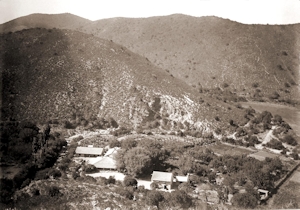
Cruz Grande, ca.1908 |
CG-1c 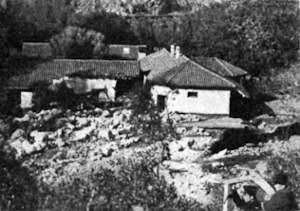
Cruz Grande soon after the flood |
|||
|
Notes re photos at right (CG-2b, CG-2c): |
CG-2b 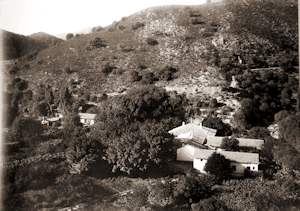
Cruz Grande, ca.1908 |
CG-2c 
Cruz Grande, map 1996 |
|||
|
CG-3a 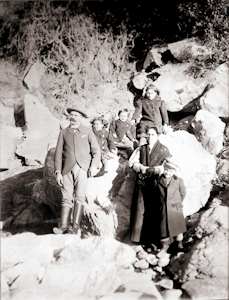
Juan & Sulema Mottino |
CG-3b 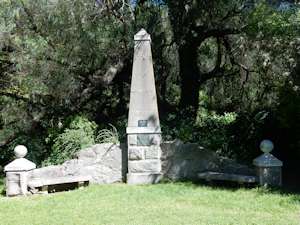
Memorial to John E. Benitz |
CG-3c 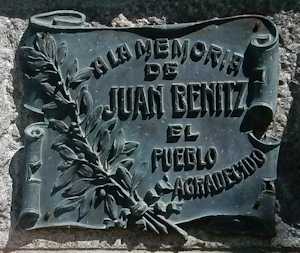
“To the Memory of |
|||
Jimmy Watt’s Photos & Diagrams, November 1996 |
|||||
|
JFW-01-A 
Cruz Grande - from the west |
JFW-01-B 
Cruz Grande - from the west |
JFW-01-C 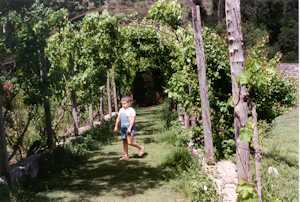
Cruz Grande - Grape arbor covered |
|||
|
JFW-02-A 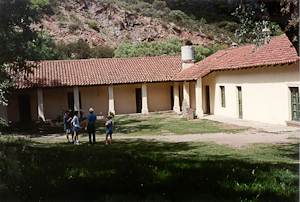
Back / East side - 1996 |
JFW-02-B 
Diagram of Back / East side - 1996 |
||||
|
JFW-03-A 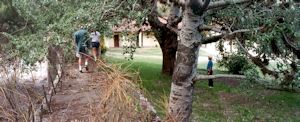
Flood Wall - 1996 |
JFW-03-B 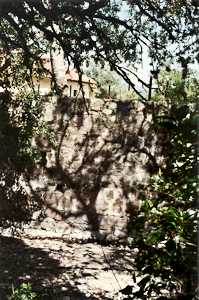
Flood Wall - 1996 |
JFW-03-C 
Diagram of the Wall’s layers |
|||
|
JFW-04-A 
North Side: Living-room |
JFW-04-B 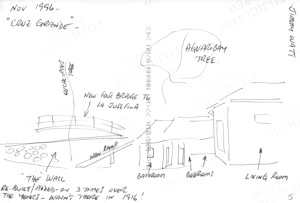
North side |
JFW-04-C 
Cruz Grande house from NW |
|||
Condolences from the governor of Córdoba province |
|||||
|
CG-10-A 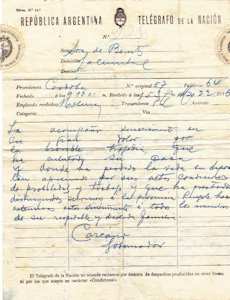
Telegram of condolences |
Telegrama recibida por Marjory Benitz La acompaño sinceramente en su gran dolor por la horrible tragedia que ha enlutado su casa
y donde ha perdido la vida su esposo tan apreciado por sus altos convenios de probilidad y
trabajo que ha prestado distinguidos servicios a la provincia. Ruegole hacer extensivas
estos sintimientos a todos los miembros de su respetable y desolada familia. |
Telegram received by Marjory Benitz I join you sincerely in your great pain caused by the horrible tragedy that has put your home
in mourning and taken the life of your husband, so appreciated for his high standards of work and probity,
he has rendered distinguished service to the province. I beg you to extend these sentiments to all the members
of your respectable and desolate family. |
|||
Newspaper & Magazine articlesCaras y Caretas - Buenos Aires, 1 April 1916 Per Wikipedia, Caras y Caretas is a weekly magazine published in Argentina from 1898 to 1941, and relaunched in 2005. However, this article is copyrighted by the Bibliotequa Nacional de España. The translations are ours. |
|||||
|
CG-11-A 
Caras y Caretas |
Impact of the floods in Cruz Grande Don Juan Benitz, a well known member of the North-American community, had lived in the country since 1874, and had earned a solid and respected role in agriculture. He owned in Cruz Grande, province of Córdoba, a beautiful countryside residence, where his family had gone lately for the summer. |
PHOTOS: |
|||
© Peter Benitz (Benitz Family)